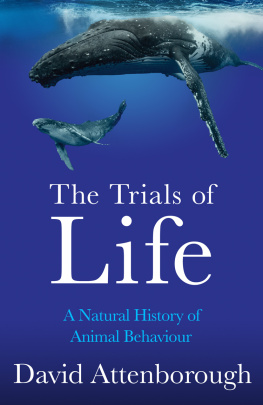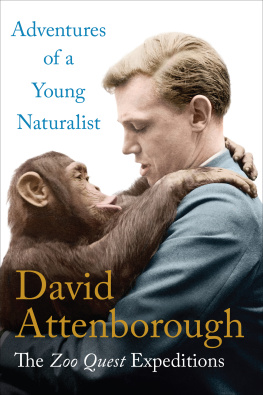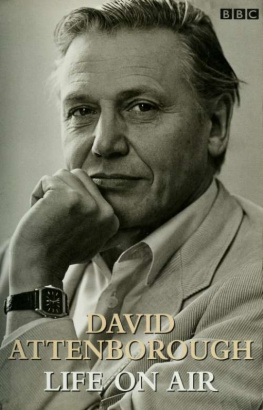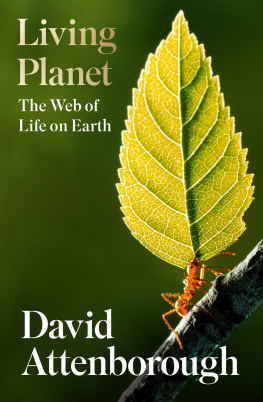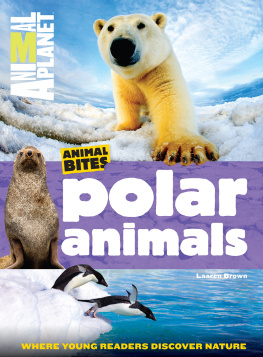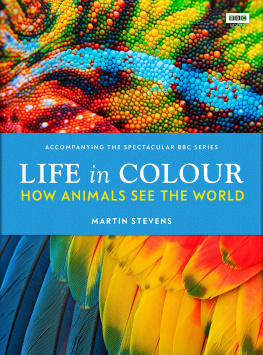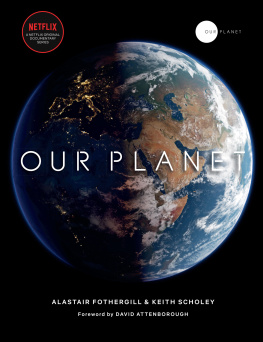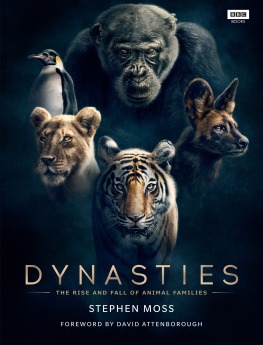David Attenborough is one of the worlds leading naturalists and broadcasters. His distinguished career spans more than sixty years, and his extraordinary contribution to natural history broadcasting and film-making has brought him international recognition, from Life on Earth to Frozen Planet, Planet Earth to Blue Planet. He has achieved many professional awards, honours and merits, including the CBE and OM, and was knighted in 1985.
The third and final updated edition of David Attenboroughs classic Life trilogy. Life on Earth covered evolution, Living Planet, ecology, and now The Trials of Life tackles ethology, the study of how animals behave.
Animals, including ourselves, endure all kinds of hardships and overcome all kinds of difficulties. Predators are foiled, food is gathered, rivals are fought, mates selected and the complexities of copulation negotiated until at last the next generation is brought into existence. Then it is their turn to carry the genes through yet another cycle of the never-ending trials of life.
Australia
HarperCollins Publishers Australia Pty. Ltd.
Level 13, 201 Elizabeth Street
Sydney, NSW 2000, Australia
www.harpercollins.com.au
Canada
HarperCollins Canada
Bay Adelaide Centre, East Tower
22 Adelaide Street West, 41st Floor
Toronto, Ontario M5H 4E3, Canada
www.harpercollins.ca
India
HarperCollins India
A 75, Sector 57
Noida, Uttar Pradesh 201 301, India
www.harpercollins.co.in
New Zealand
HarperCollins Publishers New Zealand
Unit D1, 63 Apollo Drive
Rosedale 0632
Auckland, New Zealand
www.harpercollins.co.nz
United Kingdom
HarperCollins Publishers Ltd.
1 London Bridge Street
London SE1 9GF, UK
www.harpercollins.co.uk
United States
HarperCollins Publishers Inc.
195 Broadway
New York, NY 10007
www.harpercollins.com
I doubt if any one individual could have witnessed first-hand all the many activities described in the preceding pages. Certainly I have not. In many instances, I have based my accounts on detailed descriptions published in learned journals and elsewhere by zoologists. These sources are so numerous and disparate that listing them all would hardly be appropriate in a book of this kind, but like anyone writing on scientific subjects, whether specialised or popular, I could only write what I have because of the labours and observations of innumerable predecessors.
Some of the animal dramas I have of course seen first hand, but I would have seen few even of these were it not for the help and guidance generously given by researchers who have studied the animals concerned, often for many years. I became personally indebted during our journeys in Africa to Christophe and Hedwige Boesch, Mark Collins, Hussein Isack, Paul Kabochi, Cynthia Moss, Craig Packer, Joyce Poole and Rudiger Wehner; in North America to Victor van Ballenberghe, John Fitzpatrick, John McCosker, Gary McCracken, Chris OToole, Henriette Richard, Mel Sunquist and Glen Wolfenden; in South and Central America to Anne Brooke, Claudio Campagna, Nigel Franks and Larry Gilbert; on Christmas Island to Hugh Yorkston; in the Bahamas to Denise Herzing; in Samoa to Lui Bell and Karl Marshall; in Malaysia to Ivan Polunin and Jason Weintraub; in Russia to Alexei Suvarov and Kathy Wynne-Edwards; in Ireland to Christopher Moriarty; in New Zealand to Chris Robertson; and in Australia to Dawn and Cliff Frith, Chris Hill and Peter Jacklyn.
In some instances, I have used as a source of information film shot by cameramen working on the television series. Their sharp, discriminating and knowledgeable eyes revealed many aspects of animal behaviour with a special clarity and on occasion some details that had never been noted before. So I am very grateful to them too. Nor are cameramen the only members of the television team to whom I am indebted. Researchers discovered stories that hitherto were unknown to me; recordists and production assistants, listening to my words being spoken in the field, gently reproved me if my thoughts were being expressed unclearly; directors and producers, by hard argument, forced me to clarify my ideas and often converted me to their way of thinking.
I am also most grateful to Myles Archibald of William Collins Publishers who suggested that there should be a new edition of the book, and to Rachelle Morris and Laura Sutherland who brought together the photographs with which it is illustrated.
Finally I must thank Professor Matthew Cobb of the University of Manchester who has read the entire book to ensure that, although there have been many advances in our understanding of animal behaviour in recent years, the text still retains its accuracy.
The Life Trilogy
Life on Earth (new edition 2018)
Living Planet (new edition 2021)
The Trials of Life (this new edition 2022)
The Life on Land Series
The Private Life of Plants (1994)
Life in the Undergrowth (2005)
Life in Cold Blood (2007)
The Life of Birds (1998)
The Life of Mammals (2002)
Other Titles
Zoo Quest to Guiana (1956)
Zoo Quest for a Dragon (1957)
Zoo Quest to Paraguay (1959)
Quest in Paradise (1960)
Quest under Capricorn (1963)
The Tribal Eye (1976)
Life on Air: The Memoirs of a Broadcaster (1987)
David Attenboroughs Life Stories (2009)
David Attenboroughs New Life Stories (2011)
Drawn from Paradise: The Discovery, Art and Natural History of the Birds of Paradise (2012) with Errol Fuller
Adventures of a Young Naturalist: The Zoo Quest Expeditions (2017)
Journeys to the Other Side of the World: Further Adventures of a Young Naturalist (2018)
A Life on Our Planet: My Witness Statement and a Vision for the Future (2020) with Jonnie Hughes
I t is midnight on the coast of Christmas Island in the Indian Ocean, five hundred kilometres south of Java. The November moon is in its third quarter and the tide is coming in. Behind the narrow sandy beach stands a sheer cliff of coral rock, twenty metres high. On its vertical face, clinging beneath overhangs, jammed three or four deep into cracks, are a million scarlet crabs. In places, they are so crowded that their bodies touch and the cliff seems to have been painted crimson. These crabs are found nowhere else in the world. They are large animals with glossy rounded shells eight centimetres across. All are females, each with a huge mass of brown eggs bulging beneath the semi-circular flap on her underside. They are about to spawn.
A month ago they, together with the males, left the burrows on the floor of the forest inland where they had spent most of the year and began a long march to the coast. Then the vast size of their population became dramatically apparent. There were about forty-five million of them. They moved mostly in the early morning or the evening, for they dry out easily and cannot withstand the full tropical sun. But when the sun went behind clouds, and particularly after a rain shower when the undergrowth was moist, they travelled during much of the day up to twelve hours at a stretch, compared to only ten minutes during the dry season. Nothing deterred them. In places their traditional routes cross roads made by the people who now live on Christmas Island. Thousands of the marchers were inevitably crushed beneath the wheels of the traffic but still, day after day for two weeks or so, they kept coming. When they reached the coast, the males excavated burrows and there mated with the females. The males then returned inland, but the females had to wait in the burrows for a further two weeks while their fertilised eggs matured.

